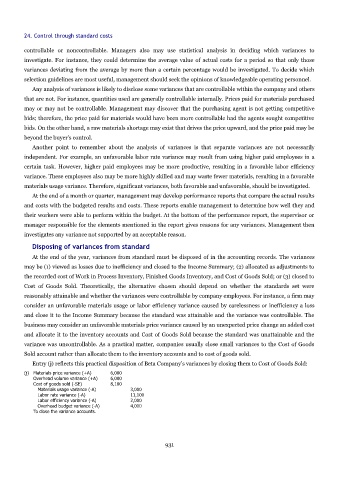Page 930 - Accounting Principles (A Business Perspective)
P. 930
24. Control through standard costs
controllable or noncontrollable. Managers also may use statistical analysis in deciding which variances to
investigate. For instance, they could determine the average value of actual costs for a period so that only those
variances deviating from the average by more than a certain percentage would be investigated. To decide which
selection guidelines are most useful, management should seek the opinions of knowledgeable operating personnel.
Any analysis of variances is likely to disclose some variances that are controllable within the company and others
that are not. For instance, quantities used are generally controllable internally. Prices paid for materials purchased
may or may not be controllable. Management may discover that the purchasing agent is not getting competitive
bids; therefore, the price paid for materials would have been more controllable had the agents sought competitive
bids. On the other hand, a raw materials shortage may exist that drives the price upward, and the price paid may be
beyond the buyer's control.
Another point to remember about the analysis of variances is that separate variances are not necessarily
independent. For example, an unfavorable labor rate variance may result from using higher paid employees in a
certain task. However, higher paid employees may be more productive, resulting in a favorable labor efficiency
variance. These employees also may be more highly skilled and may waste fewer materials, resulting in a favorable
materials usage variance. Therefore, significant variances, both favorable and unfavorable, should be investigated.
At the end of a month or quarter, management may develop performance reports that compare the actual results
and costs with the budgeted results and costs. These reports enable management to determine how well they and
their workers were able to perform within the budget. At the bottom of the performance report, the supervisor or
manager responsible for the elements mentioned in the report gives reasons for any variances. Management then
investigates any variance not supported by an acceptable reason.
Disposing of variances from standard
At the end of the year, variances from standard must be disposed of in the accounting records. The variances
may be (1) viewed as losses due to inefficiency and closed to the Income Summary; (2) allocated as adjustments to
the recorded cost of Work in Process Inventory, Finished Goods Inventory, and Cost of Goods Sold; or (3) closed to
Cost of Goods Sold. Theoretically, the alternative chosen should depend on whether the standards set were
reasonably attainable and whether the variances were controllable by company employees. For instance, a firm may
consider an unfavorable materials usage or labor efficiency variance caused by carelessness or inefficiency a loss
and close it to the Income Summary because the standard was attainable and the variance was controllable. The
business may consider an unfavorable materials price variance caused by an unexpected price change an added cost
and allocate it to the inventory accounts and Cost of Goods Sold because the standard was unattainable and the
variance was uncontrollable. As a practical matter, companies usually close small variances to the Cost of Goods
Sold account rather than allocate them to the inventory accounts and to cost of goods sold.
Entry (j) reflects this practical disposition of Beta Company's variances by closing them to Cost of Goods Sold:
(j) Materials price variance (+A) 6,000
Overhead volume variance (+A) 6,000
Cost of goods sold (-SE) 8,100
Materials usage variance (-A) 3,000
Labor rate variance (-A) 11,100
Labor efficiency variance (-A) 2,000
Overhead budget variance (-A) 4,000
To close the variance accounts.
931

